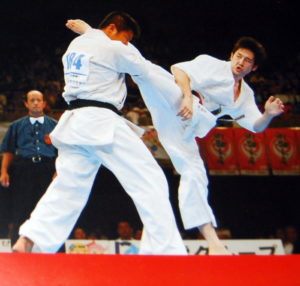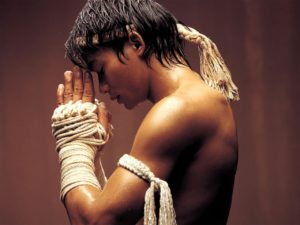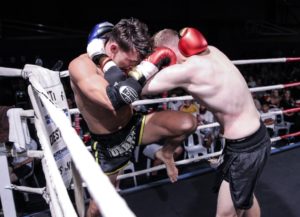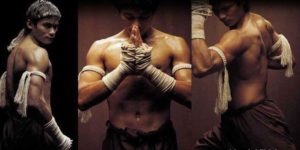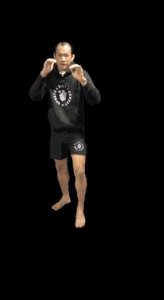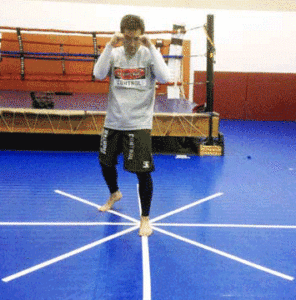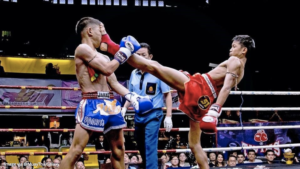People so often interchange the terms “Muay Thai” and “Kickboxing” in Brisbane that some no longer see if there is any distinction at all. The confusion between Muay Thai vs Kickboxing lies mainly in that the latter is an umbrella term encompassing any stand-up combat sport that allows both punching and kicking.
Kickboxing refers to full-contact fighting using kicking and punching. It is not a specific martial arts style, and Kickboxers can come from various backgrounds. In Kickboxing matches, fighters from different backgrounds may face off against each other. For example, a Thai boxer may face a Karateka under kickboxing rules. Muay Thai is one of the most popular Kickboxing styles, though there are other well-known systems as well.1
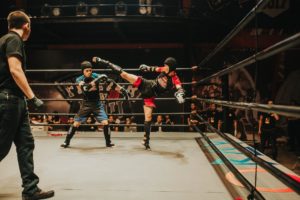
The traditional Muay Thai stance is squared (facing forward), the bladed kickboxing stance can allow for more movement.
A few other examples are American and Dutch Kickboxing. (The latter happens to be inaccurately called Dutch Muay Thai.) Most forms of Kickboxing may seem similar to the average onlooker. However, you will find the distinction once you know what to look for. Each has its complex history, affecting how they function today.
It’s starting to become more common for Muay Thai clubs and coaches to call it by its name rather than the generic Kickboxing. Maybe it’s because of the UFC’s increasing popularity, or maybe it’s because more Australians are getting more exposed to the sport. Whichever it is, this can only be good for recognizing the nuances specific to the sport.
This post aims to acknowledge what makes each of them incredibly useful in their own way. Are you training Muay Thai in Logan or interested in learning about kickboxing? You should take it upon yourself to understand what makes each sport unique.
-
1 Overview
People who do Muay Thai in Brisbane may think that Muay Thai is just Kickboxing with a fancier title. Can’t blame them, really, since Kickboxing has been around for a really long while. Sure, they have some similarities, but they are far from the same thing.
When people talk about Kickboxing, some may think of men with long hair, hairy chests, long pants, and handlebar moustaches throwing roundhouse kicks. Others may think of the massive arena events in Japan, with as much as 90,000 people in attendance. Both are fair associations to have.
Kickboxing usually has elements of Boxing and Karate. In Australia, however, the sport utilizes a lot of powerful Muay Thai kicks. Since Muay Thai technically inspired the Kickboxing we do, they look very similar. It’s very easy to think they’re the same thing, especially to the average onlooker.
But there also are a lot of differences, which is plain to see for those who know what to look out for. American and Dutch Kickboxing have a strong boxing influence. It emphasizes the strategic use of punches and kicks, incorporating angles and movements. On the other hand, Muay Thai relies on swift execution. With precise strikes, fighters go in for the kill with lethal attacks.
-
2 History
American Kickboxing
American Kickboxing is a hybrid art that began in the 1970s. Karatekas (i.e., karate practitioners) disagreed with the traditional Karate point-fighting system. They branched out and created full-contact karate. Thus came the Professional Karate Association.2
Full Contact Karate is the origin of American Kickboxing.
The PKA’s World Championships of Full Contact Karate brought together diverse fighting styles. Later, it instituted a standard set of rules to unify these styles, so American Kickboxing came to be.
Dutch Kickboxing
Dutch Kickboxing has a long history that began around the same time. 3 Dutchmen travelled to Japan to learn Japanese Kickboxing, a mix of Muay Thai and Kyokushin Karate which originated in the late 1950s. They brought Japanese Kickboxing back to the Netherlands and incorporated Western boxing. Years of refining this system resulted in the modern rules Dutch Kickboxers play by today.
Muay Thai
Muay Thai came from Muay Boran, the unarmed form of combat used by the Siamese soldiers of Thailand during the war. It became a ring sport around the 1930s, and with it came measures to keep athletes safe. Modern fighting equipment were introduced, as were a change of rules.
Muay Thai came to the Western world almost two decades after American and Dutch Kickboxing did. 4 Muay Thai or Thai Boxing is also known as The Art of Eight Limbs. It is an eight-point striking system, using hands, elbows, knees, and shins to inflict damage.
In the late ‘80s, a Thai sparked the interest of the public and a few influential people. 5 It was in a tenacious display in a match against one of the top American kickboxers at the time. A few decades (and several Muay Thai fighters) later, Muay Thai has become one of the most popular fighting systems in the world.
-
3 Philosophy
Frankly, there is no known ideology to American Kickboxing. It earned the term “karate without philosophy,” though that’s not to say that its practitioners follow no code. Generally, people who compete in Kickboxing already have foundations in other martial arts. 6 In that case, their original school greatly influence their personal code.
Dutch Kickboxers (and the Dutch population in general) have a mindset of “if it ain’t Dutch, it ain’t much.” Aside from that, though, they also seem to have no overarching philosophy.
The Muay Thai philosophy is the core of all traditional practices in Muay Thai.
On the other hand, traditional Muay Thai philosophy remains significant today. Muay Thai is a very orthodox martial art deeply rooted in its core beliefs. This philosophy affects everything from the day students joins their beginner Muay Thai lessons.
The Thai believe that you can only grow as a fighter if your heart, mind, and body are all in sync. 7 No amount of physical conditioning will make up for lack of dedication and concentration. This is why Thai practitioners follow a strict daily routine. Training twice daily and immersing in Buddhism is the norm. 8
-
4 Grading System
The similarity between Muay Thai vs Kickboxing is that there are no formal rankings. Instead, each practitioner’s performance and record speak for themselves. However, such a vague measurement of skill makes it hard to assess students. Schools then usually use a belt ranking system for the sake of assessment.
-
5 Rules
Kickboxing has many rulesets, and the rules implemented in events depend on the promotion, the sanctioning body, and whether it’s a title fight or not. Each rule sets have their own restrictions, but here are the most common ones, especially a few decades back:
- Kicks are only allowed above the waist.
- You can only punch or kick.
- No clinches and holds. (To make things more entertaining for the viewers.)
- There’s a minimum number of kicks per round. (After which some fighters end up boxing their way until the round ends.)
Thankfully, promotions today are moving away from the generalized Kickboxing and towards specific rule sets. Here are some examples:
Muay Thai
Muay Thai rules are very generous. The use of hands, elbows, knees and shins are all fair play. Even groin strikes are legal moves (Yikes!). And while they do advocate the use of groin cups, a hit is still pretty painful.
Sure, international rules have since banned it, but traditional Muay Thai has been laxer. Teeps can easily miss their intended target and hit unfortunate areas. Kicking the weight-supporting leg with the shin or top surface of the foot is accepted. However, the instep is a Judo technique and therefore not allowed.
Clinching (stand-up grappling) is a traditional Muay Thai technique illegal in other forms of Kickboxing.
Clinch fighting is common in Muay Thai, and is a form of upright grappling. It’s not unusual for fighters to be locked up in the clinch and be too close for anything other than elbows and knees.
The clinch can be quite dull to onlookers, though, so Kickboxing rules don’t allow it. Instead, fighters always stay at a distance for continuous striking to make things more entertaining.
Mod-Thai in Brisbane
Traditional Muay Thai rules will be the same regardless of the promoter hosting the event. Kickboxing rules, however, may differ depending on the event. In Brisbane, Kickboxing is also called Mod-Thai, which is short for Modified Thai Rules.
What this means is that Kickboxing in Brisbane is essentially Muay Thai with more restrictions. Elbows and knees to the head are banned, for example. This makes it quite similar to American and Dutch Kickboxing, except Mod-Thai allows clinching.
American and Dutch Kickboxing
That said, Dutch and American Kickboxing rules tone down the intensity and amp up the safety factor by implementing a few more restrictions. Sweeps are legal. The American Kickboxing rules ban elbows, knees, and kicks below the waist. These restrictions don’t always apply to Dutch Kickboxing. Muay Thai allows knees to virtually anywhere. In comparison, knees in Dutch Kickboxing are only allowed in body strikes. 9
Check out this classic match between Kickboxing and Muay Thai.
-
6 Apparel
Mouthguards, groin guards, hand wraps, and 10 oz (280 g) boxing gloves are standard in stand-up combat. Younger competitors and amateurs wear shin pads, kick boots, and headgear for safety.
Traditional Muay Thai Gear as seen in “Ong-Bak: Muay Thai Warrior.”
Muay Thai vs Kickboxing is easily identifiable when it comes to matches. Clothing is usually limited to kickboxing trousers and Muay Thai shorts for men. The same plus sports bra applies to women. (There may be some Kickboxing styles that dress more conservatively.)
Muay Thai players may wear a mongkol on their heads and prajioud on their arms. Depending on the promotion, 4 oz open-finger MMA gloves may replace boxing gloves.
-
7 Match Practices
Muay Thai is the national sport of Thailand, and it shows. The sport incorporates many practices and traditions of the country’s culture. Fighters may begin with a ceremonial dance to pay homage to their trainers, teachers, and family. This dance is called a Ram Muay.
If you’ve ever watched Muay Thai in Logan or Brisbane, you may have noticed the round music or sarama in the background. These are usually just audio files in Australian Muay Thai bouts. In Thailand, though, you get the full experience since musicians play live. They influence the fight with the tempo of the music.
Kickboxing matches can have anywhere from 3–10 rounds of 2–3 minutes each, with a minute of rest in-between. Muay Thai has shorter matches: five rounds of 3 minutes each, with a two-minute rest in-between. 10
Since kickboxing has fewer rounds to complete, fighters are very active and energized right from the start. In contrast, in Muay Thai, they ease into it and use the first and second rounds to feel out their opponent and sometimes to establish betting odds… but that’s a whole other story!
-
8 Stance and Footwork
Given the differences in rules, it only makes sense that the stance differs. In beginner Muay Thai lessons, you’ll see the coaches teach the squared stance rather than angled. The hips face forward, elbows turned out, and most bodyweight is on the back leg. It’s a very open stance—luring in attacks to set up a counter.
The most notable difference between the traditional Muay Thai stance vs boxing stance is how the body is angled.
It’s an immobile stance that is susceptible to takedowns and well-executed sweeps. It can barely block punches. However, this stance also makes it easier to shoot teeps and check kicks at any level. It’s also good for rapidly dropping (and defending against) elbow strikes. Simply put, the traditional Muay Thai stance amps up the defence from kicks and elbows. The tradeoff is less mobility, stability, and defence from punches.
The squared stance works best for Muay Thai but not for American and Dutch Kickboxing. American Kickboxing adapts a very defined bladed stance. The Dutch Kickboxing stance isn’t very bladed but isn’t squared either, landing somewhere in-between.
The bladed stance more typically seen in American Kickboxing than Dutch Style Kickboxing.
American Kickboxing is basically karate with more punches and guards. Dutch is basically boxing with some karate and Muay Thai. Both deal and receive higher volumes of punches than kicks, so they keep their arms close to their sides.
Keeping your arms close works for better defence and swift execution of punches. However, Dutch Kickboxers also have to be wary of elbows, so they slightly angle their elbows out to deal and defend against elbow strikes.
The semi-bladed stance offers greater mobility for Dutch Kickboxers to evade leg kicks. You may find that kick check response time lags compared to the fully squared stance.
-
9 Techniques
The distinction between the Muay Thai vs Kickboxing becomes obvious when fighters of different styles step into the ring. Dutch Kickboxers are very heavily oriented to Western boxing and will outbox their opponents. However, their arsenal of punches has a little more variety than boxing. Superman punches are legal, for example. The Dutch style favours barrages of punches punctuated by knees and leg kicks. Body and head kicks are legal, as well as front kicks, but they’re not really preferred.11
On the other hand, American Kickboxing allows only hits above the waist. Those hits can be punches or kicks, but no knees or elbows. It has a preference for explosive, long-range kicks. (Some people believe it is because promoters wanted flashier demonstrations of power.) It doesn’t allow backfists as Muay Thai and the Dutch style do.12
The traditional Muay Thai stance makes it easier to throw a teep.
Muay Thai uses all eight striking points and puts greater emphasis on clinching. Any kick is fair play, and teeps are very commonly used. The roundhouse is a favourite. Elbows are the weapon of choice in close range and are taught even in beginner Muay Thai lessons. In fact, the mighty elbow has been responsible for KOs time and time again. Clinches are the most distinct style-specific techniques, and dumps and sweeps are good scorers in Muay Thai.13
However, Muay Thai just doesn’t put as much force behind its fists compared to Dutch Kickboxing. The Dutch style allows dumps and sweeps but doesn’t favour them as much.
There is a lot of overlap between Muay Thai, Dutch Kickboxing, and American Kickboxing, so it’s plain to see why they aren’t so easy to distinguish from each other. Once you know what you’re looking for, though, it becomes much simpler.
-
Final Thoughts
Fitness-wise, we could say that Muay Thai vs Kickboxing have the same effects. The decision on which to pick then boils down to preference. If you can’t decide which specific discipline would be best to enrol in, here are a few steps to help you:
- Learn more about the similarities and differences of each kickboxing style so you can make a well-informed choice.
- Ask yourself this: Is there even a Muay Thay gym near me? How about Kickboxing? If the closest gym to you is about an hour away, it’ll be tough for you consistently turn up at the gym.
- Enrol in beginner Muay Thai lessons to get a feel for it. Join American and Dutch Kickboxing sessions too. The best way to accurately assess your best fit is to try each of them out at least once.
From a competitive standpoint, though, we recommend going for Muay Thai. It’s easier to take away weapons than add them in. It’ll be easier to adjust to the handicap of not being able to use elbows and knees, than the demand of having to use the clinch while not knowing how to.
Luckily, in most gyms in Queensland, Kickboxing and Muay Thai go hand in hand. If you’re in the area, come train the combat sport of your choice at the TFC in Logan, Brisbane.
We offer Boxing, Muay Thai Kickboxing and Brazilian Jiu-Jitsu. It is home to to WBC World Muay Thai Champion Ben Johnston and his team of elite instructors, so you can rest assured that the quality of instruction is top-notch.

